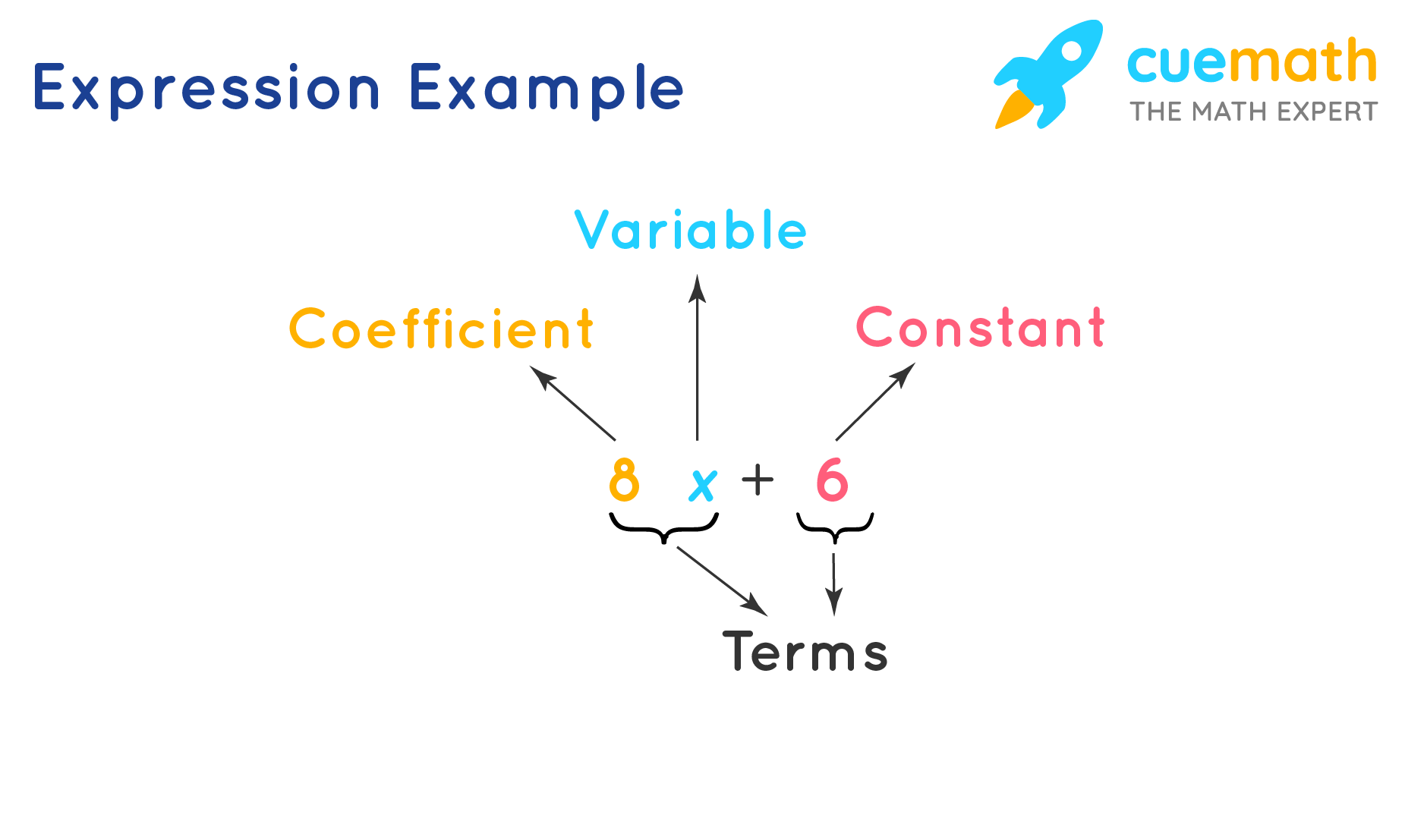Expressions in Math
Expressions in math are mathematical statements that have a minimum of two terms containing numbers or variables, or both, connected by an operator in between. The mathematical operators can be of addition, subtraction, multiplication, or division. For example, x + y is an expression, where x and y are terms having an addition operator in between. In math, there are two types of expressions, numerical expressions - that contain only numbers; and algebraic expressions- that contain both numbers and variables.
In this article, we will discuss the concept of expressions in math and their different types. We will also understand the difference between an expression and an equation in a tabular way and different types of expressions with the help of examples for a better understanding.
| 1. | |
| 2. | Types of Expressions in Math |
| 3. | Expression vs Equation |
| 4. | Simplifying Expression in Math |
| 5. | FAQs on Expressions in Math |
What is an Expression in Math?
An expression in math is a sentence with a minimum of two numbers/variables and at least one math operation in it. Let us understand how to write expressions. A number is 6 more than half the other number, and the other number is x. This statement is written as x/2 + 6 in a mathematical expression. Mathematical expressions are used to solve complicated puzzles.
Expression Definition in Math
An expression is a combination of terms that are combined by using mathematical operations such as subtraction, addition, multiplication, and division. The terms involved in an expression in math are:
- Constant: A constant is a fixed numerical value.
- Variable: A variable is a symbol that doesn't have a fixed value.
- Term: A term can be a single constant, a single variable, or a combination of a variable and a constant combined with multiplication or division.
- Coefficient: A coefficient is a number that is multiplied by a variable in an expression.
Expression in Math Example
There are infinite examples of an expression. For example, 2y-9, 3a×2, -7+6÷3, etc. Let us also look at a real-life example. Sarah told her younger brother Daniel that her age is 3 more than twice his age. She asked him to calculate her age if his age is x years. Let's help him write an expression. Twice the age of Daniel can be written as 2x. Now Sarah's age is 3 more than 2x. Therefore, Sarah's age will be written as 2x+3.

Types of Expressions in Math
There are three basic types of mathematical expressions. Based on the terms that they have, they can be classified as arithmetic/numerical expressions, fractional expressions, and algebraic expressions. Let us learn more about each of them with the help of the table given below:
| Types of Mathematical Expressions | Definition of Expression | List of Mathematical Expressions |
|---|---|---|
| Numerical Expression | Contains only numbers and mathematical operators | 40-5+2 |
| Fractional Expression | Contains fractional numbers and mathematical operators | 5/3 - 7/6 |
| Algebraic Expression | Contains variables, numbers, and mathematical operators | 3x+2y |
Now, algebraic expressions are further classified into monomials, binomials, trinomials, etc. They are also termed as polynomials. Let us look at the types of algebraic expressions in the table given below:
| Category | Definition of Expression | Examples |
|---|---|---|
| Monomial | An expression having a single term with non-negative exponential integers. | 2x2 |
| Binomial | An expression formed by the addition or subtraction of two monomials. | 2x2+5xy |
| Trinomial | An expression formed by the addition or subtraction of three monomials. | 2x2+5xy+4yz |
| Polynomial | An expression formed by one or more monomials. | 2x2+5xy+4yz+2y+3 |
Expression vs Equation
In math, expressions and equations are two different concepts. Let us try to understand the difference between the two. An expression can be a number, a variable, or a combination of numbers and variables connected by mathematical operators, i.e., addition, subtraction, multiplication, and division. On the other hand, an equation is the equality relation between two expressions. Look at the table given below to understand it better:
| Expression | Equation |
|---|---|
| Expressions are only one-sided. | Equations are two-sided (left side and right side) |
| Expressions can be simplified to have a numerical answer. | Equations can be solved to verify the equality or to find the missing values. |
| Expression is the combination of terms having operators in between. |
Equation is the combination of two expressions having an 'equal to' (=) in between. |
| Example: 3x-8 | Example: 3x-8=16 |
Look at a few more examples of expressions and equations through the figure given below:

Simplifying Expression in Math
Expressions can be simplified to form an answer. For example, 3+6-2 is an expression that can be simplified to 7. There are two different ways to simplify arithmetic expressions and algebraic expressions. We use the BODMAS rule (PEMDAS rule) to simplify them. In case of algebraic expressions, like terms can be added or subtracted for simplification. Like terms are those that have the same variable raised to the same power. So, we can easily add or subtract two or more like terms by adding their coefficients. For example, 2x+5x results in 7x, whereas 7ab-b is an expression that has two unlike terms, which cannot be added.
In the case of expressions having multiple terms and operators, we apply the PEMDAS rule (BODMAS rule). For example, let us simplify 23 - 6 + 7 × 3. Here, as there are no brackets and exponents, we will first evaluate 7 × 3 which is 21. Now, the expression is 23-6+21. Now, there are two operators, addition and subtraction. Since both are same level operations and subtraction is first from the left side, we will subtract 6 from 23, i.e., 17. Now our expression has become 17+21, which results in 38 and 38 is the simplified value of the expression 23 - 6 + 7 × 3.
Important Notes on Expressions in Math:
- An expression has 3 parts: constant, variable, and term.
- There are 3 types of expressions: arithmetic/numerical, fractional, and algebraic.
- Polynomial is a type of variable expression.
Related Articles
Expressions in Math Examples
-
Example 1: Classify the following expressions as arithmetic, fractional, or algebraic.
(a) 4/5-3/8 (b) 3 + 78 (c) x+5y
Solution:(a) 4/5 - 3/8 is a fractional expression because it contains a fractional term.
(b) 3 + 78 is an arithmetic expression because it contains only numbers and a mathematical operator, that is, "+".
(c) x+5y is an algebraic expression because it contains variables, numbers, and a mathematical operator, that is, "+".
Answer: Therefore, (a) Fractional, (b) Arithmetic, (c) Algebraic. -
Example 2: Maria, Emma, and Nia got a few ribbons. Emma has 10 more ribbons than Maria. Nia says that she has 4 more ribbons than the number of ribbons that Maria and Emma together have. Can you express this in the form of an expression?
Solution: Let the number of ribbons with Maria be x. Then, Emma has x+10 ribbons. Nia has x+(x+10)+4=2x+14 ribbons.
Answer: Therefore, Nia has 2x+14 ribbons. -
Example 3: Rosie loves to plant flowers in her square-shaped plots. She planted tulips and orchids in 2 different plots. The side of the square plot where tulips are planted is 4 feet greater than the side of the square plot where orchids are planted. Which plot area is bigger and by how much? Write this in the form of an expression.
Solution: Let the side of the orchid square plot be 'l' feet. Then, the side of the tulips square plot is (l+4) feet. Area of the square plot with orchids = l2. Area of the square plot with tulips = (l+4)2. The area of the tulips plot is bigger. The difference in the areas of these two plots can be written as: (l+4)2-l2 = l2+16+8l-l2 = 16+8l.
Answer: Therefore, the required expression is 16+8l.

FAQs on Expressions in Math
What is Expression in Math?
Expressions in math are mathematical statements that have a minimum of two terms containing numbers or variables, or both, connected by an operator in between. We have different types of expressions in math such as numerical expressions, algebraic expressions, fractional expressions, etc.
How do you Identify Like Terms in Mathematical Expressions?
Like terms, in an expression have the same variables raised to the same power. For example, 5x, −x, and −3x are all like terms.
How do you Write an Expression in Math?
We write an expression in math by using numbers or variables and mathematical operators which are addition, subtraction, multiplication, and division. For example, the expression of the mathematical statement "4 added to 2", will be 2+4.
What is a Numerical Expression?
A numerical expression consists of numbers and operators. Numerical expressions are also called number expressions. Examples of number expressions are 8 - 7, 3 + 6 × 7 - 3, etc.
How Many Terms are there in an Expression?
There can be any number of terms in an expression. Expression is a mathematical phrase that consists of terms separated by operators in between. So, we can have an expression with 1 term, 2 terms, 3 terms, or n number of terms.
What is the Difference Between Mathematical Expression and Algebraic Expression?
Generally, mathematical expressions or numerical expressions have only numbers and operators, while algebraic expressions have both numbers and variables in terms, separated by operators in between.
Can you Solve an Expression in Math?
Since expressions do not have an 'equal to' sign (=) we cannot solve them. We can only simplify expressions and find their reduced form using the given mathematical operators.
How to Simplify Expressions in Math?
We can simplify expressions in math by reducing the given expression in the simplest form. If it is a numerical expression, then it can be simplified by finding the value of the expression. If it is an algebraic expression, then it can be simplified by reducing it to the simplest form such that it cannot further be reduced.
visual curriculum